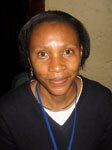Women still missing from top media posts
SADC Protocol on Gender and Development

The media clauses of the Protocol sparked heated debate. Governments expressed concern that any prescriptions could be misconstrued as interference in freedom of expression. While the clauses are not obligatory, they set out key issues and provide a framework hard to quibble with for any institution genuinely committed to equality, fairness and transparency - as all media houses, whether private or public should.
These include provisions to mainstream gender into media practices, promote equal representation, and play constructive roles in discouraging stereotypes and gender violence. The Protocol's commitment to 50/50 representation in decision-making also includes media.
Key media provisions of SADC Protocol on Gender and Development
- Ensure gender is mainstreamed in all information, communication and media policies, programmes, laws and training.
- Mainstream gender in their codes of conduct, policies and procedures, and adopt and implement gender aware ethical principles, codes of practice and policies.
- Promote the equal representation of women in the ownership of, and decision making structures of the media.
- Desist from promoting pornography and violence against all persons, especially women and children; depicting women as helpless victims of violence and abuse; degrading or exploiting women, especially in the area of entertainment and advertising, undermining their role and position in society; and reinforcing gender oppression and stereotypes.
- Give equal voice to women and men in all areas of coverage, including increasing the number of programmes for, by and about women on gender specific topics and that challenge gender stereotypes.
- Play a constructive role in the eradication of gender-based violence by adopting guidelines which ensure gender sensitive coverage.
Women missing from top posts
The research shows some positive signals. Two countries (Lesotho and South Africa) have achieved gender parity in employment. At 41%, the overall regional average for women in the media is respectable. However, without South Africa (which has by far the largest media density), the figure falls to 32%.

There are also shortfalls when it comes to women in top decision-making positions. The study found that women constitute less than 30% in the top four echelons of the media industry - 28% of those on boards of directors; 23% of top management; 28% of senior management and 31% of professionally qualified.
So why are women missing from top posts? The highest proportion of women cited the “old boys' network” as the main reason for the glass ceiling in media houses while a slightly higher proportion of men (15% compared to 14% women) cited the fact that there are no policies in media houses to advance women. Slightly more women in the region (13% compared to 12% men) also believe the men are promoted quickly to management, because they are “taken more seriously” than women.

Margaret Mangani, a journalist with the Times of Zambia has been working in the newsroom for 20 years, 17 of which were spent on the news desk and three in feature writing. She says she watched male colleagues whom she trained surpass her. Mangani claims that often those promoted to senior positions have “campaigned” for it; she describes campaigning as “giving favours to management.”
Mangani says she has tried for promotion several times, and been told to wait. She is quick to point out, “I believe my work should speak for itself. I am not that kind of person who gives favours to management.”
Women undermining women
Portia Kobue, executive producer of the SABC's Morning Live, commented that even after breaking the glass ceiling, women at the top face many challenges. “I see a lot of undermining of women in power. There is no strategy to increase women's representation at the top. Men don't do a lot to debunk the mindset that women can't lead. It is subtle — the corridor gossip.”
Kobue points out that not only men undermine women managers. “There's a lot of backbiting and undermining,” she adds. “The women that will work with you are the ones that are the pioneers in their own right; the ones that will undermine you are the non-achievers.”
Moving targets from paper to action
While 54% of the regional media houses indicated they had specific targets for achieving gender equality, the low proportion of women in management and in various departments indicate that guidelines, strategies and practices to move these targets from paper to action is still slow. No media houses in the study could point to specific targets for ensuring gender equality in decision-making in line with the SADC Gender Protocol 2015 parity target.
Perhaps one reason for slow progress is lack of understanding about gender and the SADC Gender Protocol. Asked about the target deadline for gender parity, approximately half of respondents did not know. Media is still largely unaware of these provisions; gender and media activists have their work cut out to popularise the Protocol and make its provisions a living reality in the Southern African media.
Access to politics
Women have been denied access to decision-making for a host of reasons, boiling down to social stereotypes defining women's space as being in the private rather than public sphere. Politics and the media are among the most public of public spaces and therefore the most hostile for women to access. Yet these are the most critical spheres for change.
The 50/50 campaign in Southern Africa has so far largely devoted its energies to political decision-making. There, with rare exceptions, the only instances of substantial and meaningful increases in women in parliament resulted form special measures: either legislated or voluntary quotas. However, as in politics, quotas are a thorny issue. High percentages of media men (59%) and women (49%) in the region believe quotas are “unfair.”
Quotas
Elaborated on their views, some women saw quotas as having a reverse effect on the very group that such policies are there to empower. As one female respondent asked, “Why quotas? Why can't women compete on equal measures with men? Women are as capable as men.”
Another stated “We must demand merits! Not propping up women just because we want gender balance. Quotas will not help women to progress.”
Some women in Lesotho believe quotas will make them look like “tokens,” and they want to be seen as hard working and just as able to do the job as their male counterparts. As one female respondent said, “Women should be given the chance to compete with men by introducing quotas for a certain period of time to balance the prevailing situation of imbalance. After such a period the use of quotas must stop, so that they can stand and compete on their own.”
While the current concern in media is less with women's representation overall,and more with the absence of women in decision-making, similar deliberate measures are called for. These consist of setting targets; encouraging women to apply for senior posts; coaching, mentoring, capacity building and all the other measures that are analysed in the study.





